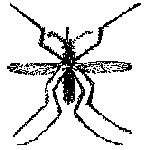Alphaviruses-

The alphaviruses are united by the fact that they are all spread by hematophagous arthropod vectors (blood sucking insects). Commonly known as arboviruses, these viruses are able to replicate within their insect vectors. The Alphaviiruses of Togaviridae are joined by viruses of Bunyaviridae, Flaviviridae, and Reoviridae as viruses that make use of insect vectors. The most common vector is the mosquito, which are inhabited by several alphaviruses. Most Alphaviruses have avian primary hosts. The virus is usually transmitted to the vector by a blood meal and replicates in the vector eventually making its way to the salivary glands where it can be transmitted to a second animal upon feeding. Thus the virus is actually amplified by the vector. The vector is usually infected for life and does not display any signs of sickness due to infection.

Alphaviruses infect man only incidentally. All alphaviruses have animal reservoirs in which the viruses normally replicate, and are only occasionally spread to man by insect vector. Alphaviruses have not been reported to be transmissible between humans through normal contact (ie fomites, entero-gastro, respiratory, fluid exchange). It is concievable, though not documented, that alphaviruses could be transmitted through donated blood or organs. Vector transmission from human to human has not been observed to occur as the viral concentration in the human host is too low to be effectively transferred.